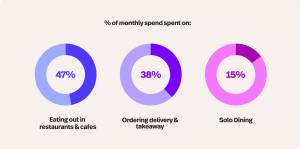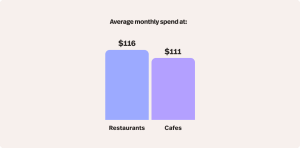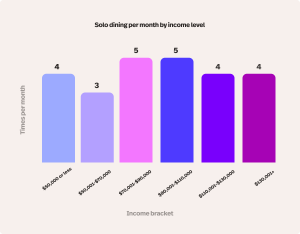
Australia is a nation of diners.
It is part and parcel of Australian culture that we enjoy heading out to share a meal with friends and loved ones. But it’s becoming increasingly important to understand how, where and why we’re spending our dining dollars is shifting—and quickly.
The latest data from Lightspeed’s 2025 Hospitality Report paints a picture of a dining landscape in flux. On the surface, it may look like business as usual. We’re still patronising our local restaurants, bars and cafes on a regular basis with familiar rhythms. But dig a little deeper, and you’ll see a distinct change in tempo.
In this blog, we’ll unpack what’s really going on with Australia’s dining habits, how they’ve evolved year-over-year, and—most importantly—what it means for restaurants, cafes and hospitality operators who want to stay ahead of the curve.
Let’s get into it.
- Eating out is still king—but cafes are keeping pace with restaurants
- Solo dining is rising
- Takeaway is booming—and it’s not slowing down
- Delivery is still growing
- The takeaway (pun intended)
Hospitality Insights & Dining Dynamics '25
Lightspeed has surveyed over 1000 hospitality operators and more than 2,000 consumers to show you which dining trends are on the rise in Australia in 2025. Download the full report for free today.
Eating out is still king—but cafes are keeping pace with restaurants
 According to the latest Lightspeed data, Australians spend 47% of their monthly dining budget eating out in restaurants and cafes, compared with 38% spent on delivery and takeaway and 15% spent on solo dining respectively. On the surface, that might seem expected. But take a closer look and something interesting emerges: cafe dining is nearly on par with restaurant spend.
According to the latest Lightspeed data, Australians spend 47% of their monthly dining budget eating out in restaurants and cafes, compared with 38% spent on delivery and takeaway and 15% spent on solo dining respectively. On the surface, that might seem expected. But take a closer look and something interesting emerges: cafe dining is nearly on par with restaurant spend.

That’s a surprisingly narrow gap, and it suggests cafe culture in Australia is more than just flat whites, banana bread and babychinos. It’s a very significant portion of the dining economy, and one dedicated to an experience that’s arguably more flexible, informal and embedded in people’s routines than the traditional sit-down restaurant experience.
The data backs this up, with more of the monthly average spend going towards cafe dining ($68) than on coffee alone ($43).
What does this mean for operators?
It might be time for restauranteurs to borrow a page or two from the cafe playbook.
Cafes tend to offer faster service, a more approachable atmosphere for solo dining and spaces that double as social hubs or solo workstations. This doesn’t necessarily mean that you should go ahead and provide every table with a plug socket and lumbar-supporting seating, more that it’s an opportunity to rethink how you present your venue to appeal to a dining public keen for something a little more casual. Leaning into the kind of versatility on offer at cafes could help capture more spend from customers who want the dining-out experience without the bells and whistles of a full, sit-down service.
Solo dining is rising
Another quietly fascinating insight in our data sheds light on something uniting diners across the land: solo dining.
Now, dining alone isn’t anything new, but there is some very interesting data around it that warrants highlighting.
You see, whether someone earns under $50K or over $130K, the solo dining rate barely moves an inch.
And while the amounts people spend per occasion varies in tandem with their incomes, it’s the frequency of these solo dining experiences that remain constant at an average of 4 times per month.
That’s a clear signal of shifting social norms. The table for one used to be something of an oddity, something people rushed through or avoided entirely. Now? It’s becoming a regular part of urban life.
This could be down to a multitude of reasons. Solo diners might be office workers grabbing lunch, freelancers working out of cafes or people simply enjoying a bit of peace and quiet while having a meal free of small talk and conversation.
Absolute bliss.
How venues can adapt:
- Rethink seating layouts: Smaller tables, bar seating or window-facing spots make solo diners feel welcome.
- Create “table-for-one” experiences: Consider offering solo set menus, efficient service options (like digital ordering) or entertainment like free reading material.
- Train staff accordingly: A warm welcome and zero awkwardness go a long way to making solo diners feel more comfortable.
So while solo diners might not bring the biggest bills, they bring consistency. If you make them feel seen, they’ll keep coming back, time and time again.
Want to stay a step ahead of the dining competition in 2025?
Lightspeed has surveyed over 1000 hospitality operators and more than 2,000 consumers to show you which dining trends are on the rise in Australia in 2025. Download the full report for free today.
Takeaway is booming—and it’s not slowing down
While eating out accounted for nearly half of customers’ monthly dining spend, takeaway and delivery aren’t far behind at 38%. And while the average spend is lower, with $98 for delivery and $87 for takeaway, the frequency is much higher, evening out the playing fields.
Our data shows that Australians get takeaway every 5 days, compared to every 9 days for dine-in at a restaurant or cafe.
But here’s where it gets really interesting: takeaway orders have grown 34% year-over-year (YoY), far outpacing both dining out (8% YoY growth) and delivery (7% YoY growth). Let that sink in.
Let that sink in.
Takeaway isn’t just holding steady—it’s booming. And it’s growing faster than almost any other category in the data.
Why the surge?
A few factors could be at play here:
- Speed and convenience: Takeaway offers immediacy without the delivery fees or wait times.
- Value perception: Takeaway often feels like better value than delivery, even if it’s from the same venue.
- Habit formation: Pandemic-era behaviours have stuck around. For many, takeaway has become a regular fixture of weekly life.
What can restaurants do?
If takeaway isn’t already a serious part of your offering, now’s the time to perhaps start considering it, but there are a few factors to take on board. Can your menu travel well? Are pickup workflows efficient? Are your takeaway offerings priced smartly—and do they have the same appeal as your dine-in dishes?
Operators that treat takeaway as a thoughtful extension of their brand (not just a tacked-on service) are far more likely to see long-term success. That might mean redesigning packaging, adding exclusive takeaway bundles or tweaking portion sizes to suit solo and duo diners on the move.
Delivery is still growing
Despite its slower YoY growth (7%), delivery remains a reliable contributor to overall spend. But its growth has clearly plateaued compared to the boom seen during and immediately after lockdowns. In a post-pandemic world, diners are savvier—they’re noticing delivery fees, wait times and inconsistent food quality.
Delivery isn’t disappearing, but the novelty is starting to wear off.
For operators, that means one thing: If you’re offering delivery, it had better be excellent. That means hot food arrives hot, cold food arrives fresh and the experience feels intentional—branded packaging, sealed bags and a menu that’s been optimised for travel.
In an environment where takeaway is booming and dining out is rebounding, delivery needs to earn its place in the hearts and minds of Australian diners.
The takeaway (pun intended)
So, what does all this add up to?
Australians are still dining out—but it’s the shape of that dining experience that is evolving.
Cafes are competing toe-to-toe with restaurants for dining dollars. Takeaway is growing at lightning speed and becoming the go-to for quick, frequent meals. Delivery is stable, but diners are more discerning than ever. And solo dining is here to stay—only it’s more universal than you might think.
For restaurant operators, the message is clear: the habits of diners are changing, and your business needs to move with the changes. What this looks like is up to you.
That might mean adapting your physical space to welcome more solo guests. Or rethinking your takeaway menu as a brand-building opportunity instead of a bolt-on. Maybe even borrow some of that cafe versatility to capture a wider slice of the daily spend? It’s your choice to decide what works best for your business.
The key here is to stay flexible. Keep your finger on the pulse. And remember that the customer experience doesn’t begin and end on the dining room floor—it extends to every touchpoint, from the takeaway counter, to the seat on the bar, all the way to the coffee table in your customer’s living rooms.
I suppose the best takeaway from this is that Australia’s dining scene isn’t shrinking, it’s merely shifting. And for those willing to shift with it, there’s never been a better time to meet the moment.

News you care about. Tips you can use.
Everything your business needs to grow, delivered straight to your inbox.


